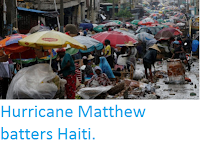Ten people have now been confirmed dead on Caribbean islands hit by Hurricane Irma this week, with it likely that many more deaths are yet to be reported due to the extensive damage the storm has caused. Eight people are known to have died on the French half of the Island of St Martin, where the storm is reported to have levelled 95 % of all buildings. On the island of Barbuda about 90% of buildings have been flattened and a two-year-old child has been reported dead, while one death has been confirmed on the British island of Anguilla.
Damage left by Hurricane Irma on the Dutch part of the island of St Martin. Gerben Van Es/AFP/Getty Images.
Hurricane Irma was a Category 5 storm when it passed over the islands, with sustained winds in excess of 250 km per hour and gusts considerably stronger. After passing over Barbuda, St Martin and Anguilla the storm swept across the British and US Virgin Islands, where it is likely to have caused further, as yet unreported, fatalities, then to the north of Peurto Rico, the Dominican Republic and Haiti, and is currently heading towards the Bahamas and Florida, where authorities have organised mass evacuations.
The path and strength of Hurricane Irma. Thick line indicates the
past path of the storm (till 3.00 pm GMT on Thursday 7 September 2017),
while the thin line indicates the predicted future path of the storm,
and the dotted circles the margin of error at six and twelve hours
ahead. Colour indicated the severity of the storm. Tropical Storm Risk.
Tropical storms are caused by the warming effect of the Sun over
tropical seas. As the air warms it expands, causing a drop in air
pressure, and rises, causing air from outside the area to rush in to
replace it. If this happens over a sufficiently wide area then the
inrushing winds will be affected by centrifugal forces caused by the
Earth's rotation (the Coriolis effect). This means that winds will be
deflected clockwise in the northern hemisphere and anti-clockwise in the
southern hemisphere, eventually creating a large, rotating Tropical
Storm. They have different names in different parts of the world, with
those in the northwest Atlantic being referred to as hurricanes.
Damage caused by Hurricane Irma on the French part of the island of St Martin. Rinsy Xing/AFP/Getty Images.
Despite the obvious danger of winds of this speed, which can physically
blow people, and other large objects, away as well as damaging buildings
and uprooting trees, the real danger from these storms comes from the
flooding they bring. Each drop millibar drop in air-pressure leads to an
approximate 1 cm rise in sea level, with big tropical storms capable of
causing a storm surge of several meters. This is always accompanied by
heavy rainfall, since warm air over the ocean leads to evaporation of
sea water, which is then carried with the storm. These combined often
lead to catastrophic flooding in areas hit by tropical storms.
See also...
Follow Sciency Thoughts on Facebook.









